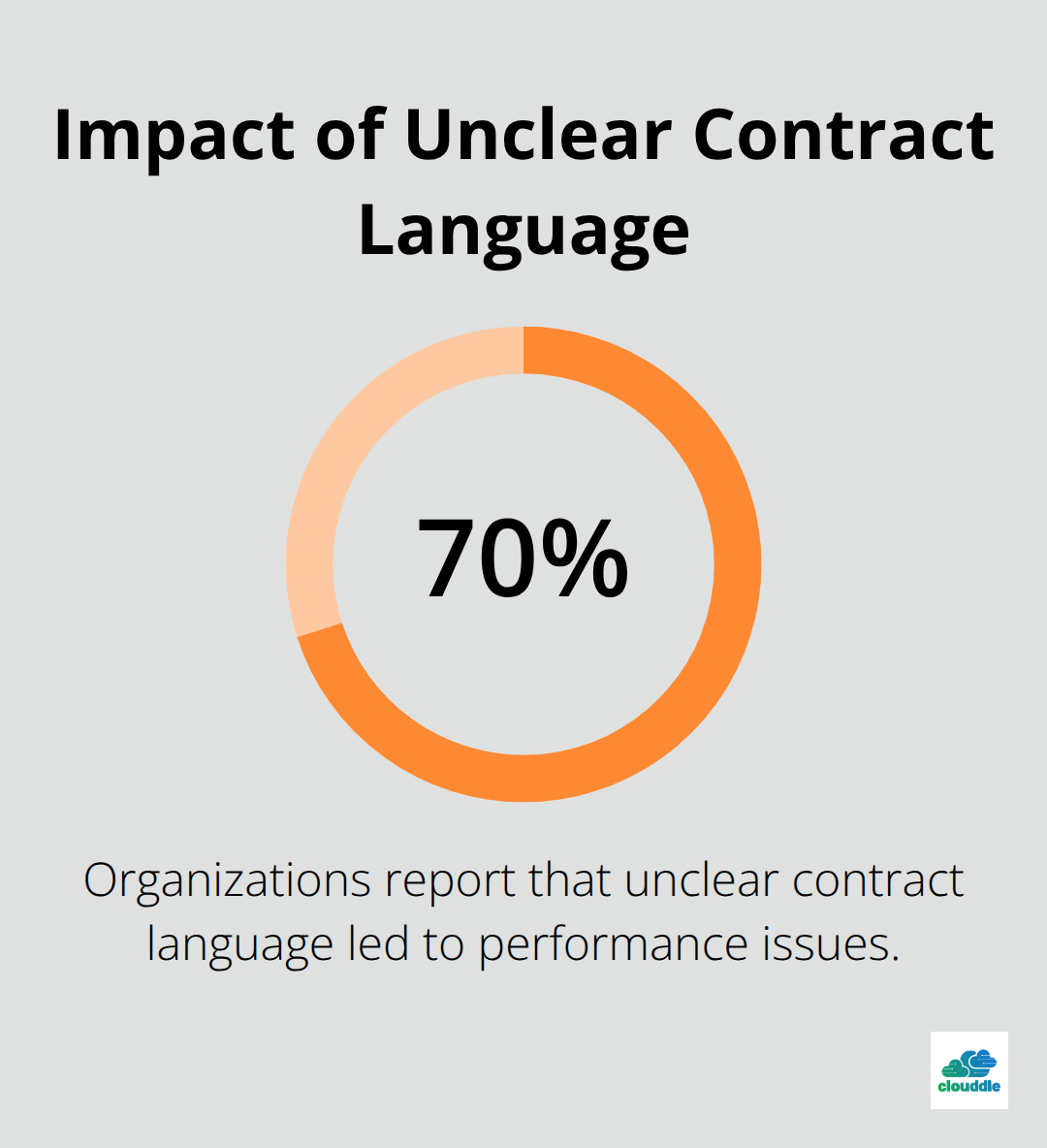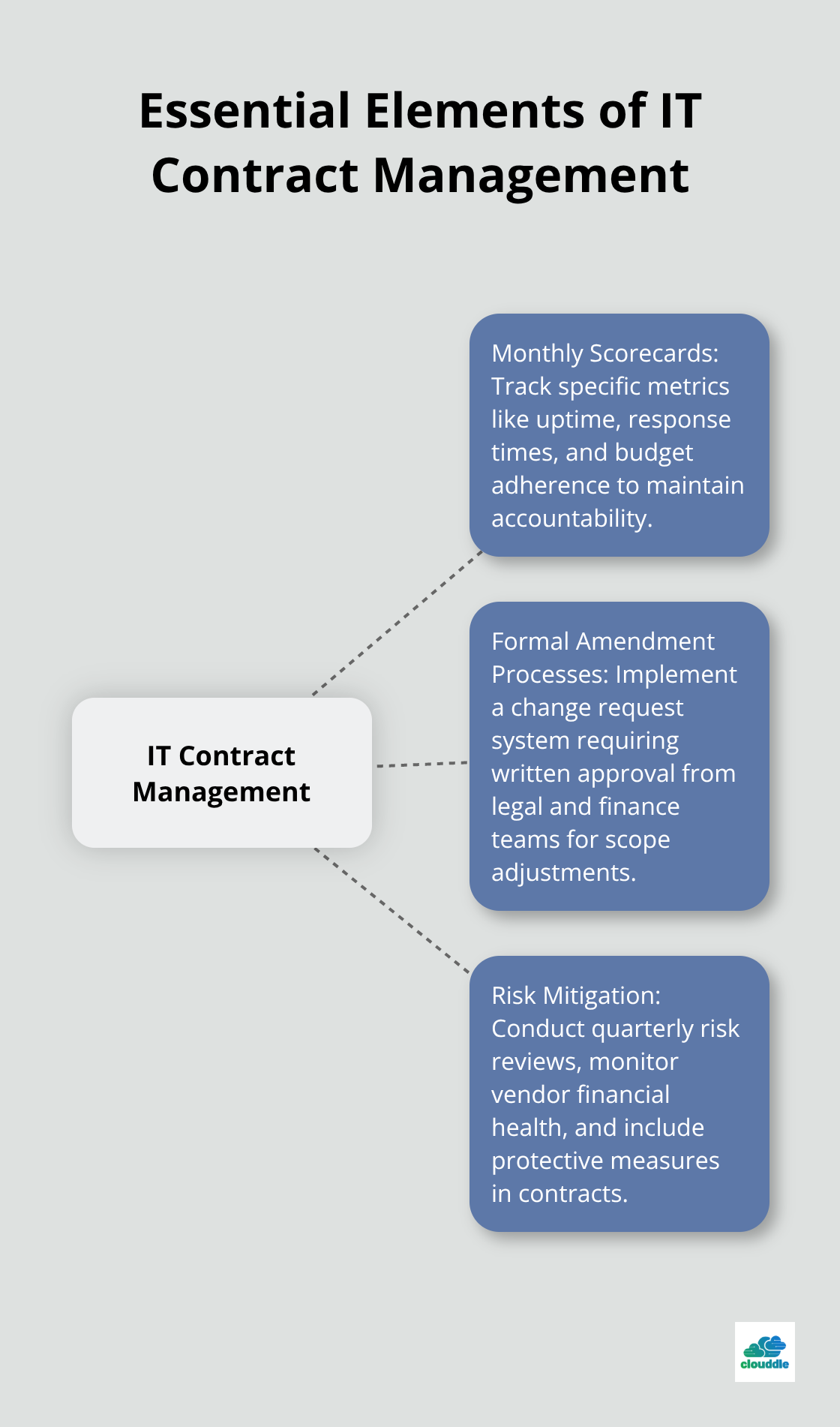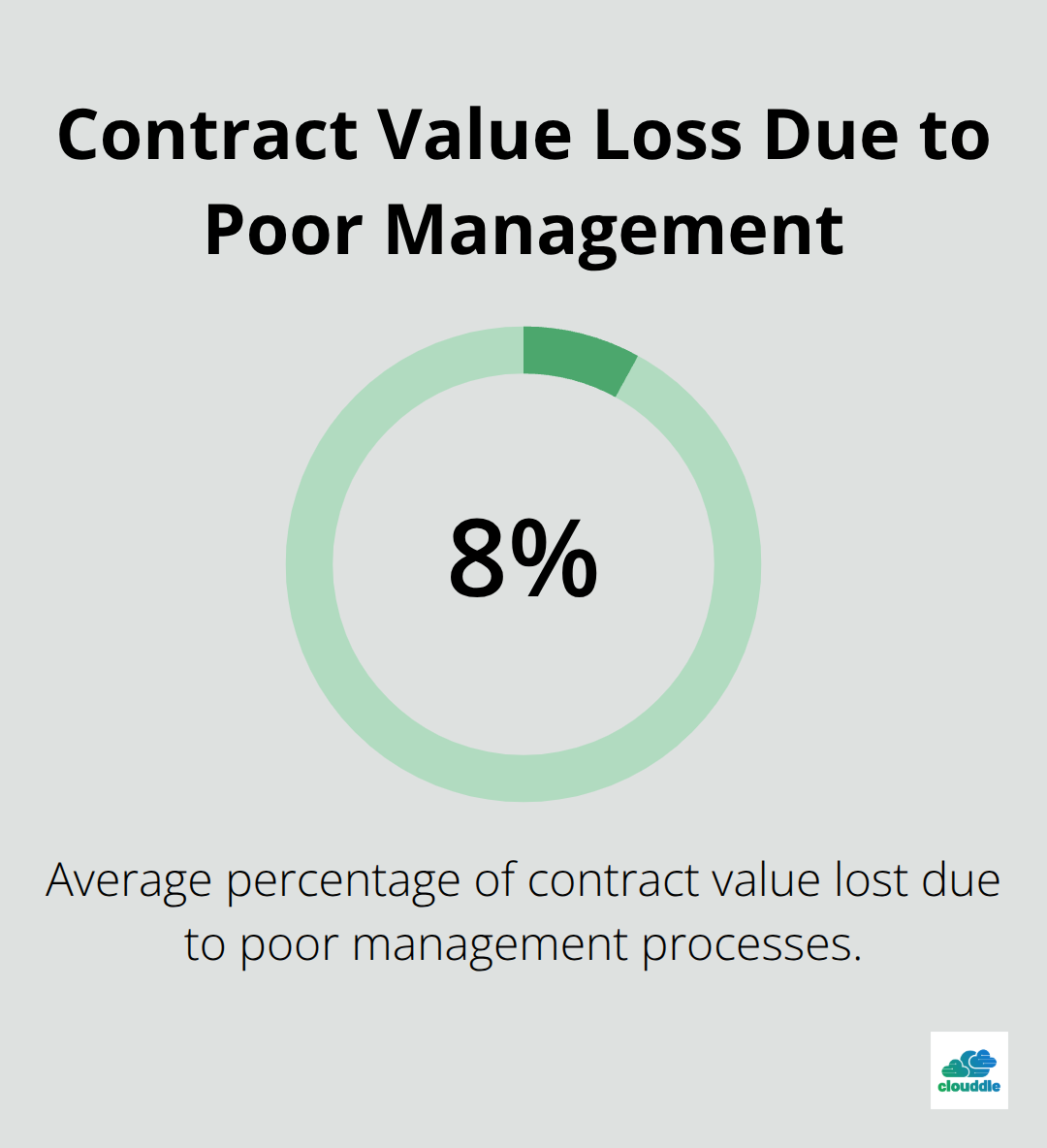IT contracts can make or break your technology partnerships. Poor agreements lead to budget overruns, missed deadlines, and legal disputes that drain resources.
We at Clouddle see companies struggle with vague terms and inadequate protection clauses daily. This IT contracts sample guide covers the essential elements that protect your business and set clear expectations for successful vendor relationships.
What Makes IT Contracts Actually Work
Scope Definition and Performance Standards
Strong IT contracts require three non-negotiable elements that separate successful partnerships from expensive disasters. The scope of work must specify exact deliverables with measurable outcomes, not vague promises. Include specific metrics like 99.9% uptime guarantees, maximum 4-hour response times for critical issues, and defined resolution timeframes.
Service level agreements should include penalty clauses when vendors miss targets and bonus structures for vendors who exceed expectations. According to the International Association for Contract & Commercial Management, 70% of organizations report that unclear contract language led to performance issues.
Payment Models and Financial Terms
Payment structures demand equal precision in your contracts. Fixed-price contracts work best for defined projects, while time-and-materials models suit maintenance work with clear hourly caps. Monthly payment schedules with 30-day terms prevent cash flow issues, and automatic late fees of 1.5% monthly keep vendors accountable.
Research shows that contracts with detailed performance indicators help build better long-term strategic partnerships. This data proves that specificity in financial terms protects both parties and creates accountability.

Data Protection and Security Requirements
Data protection requirements need the same level of detail as payment terms. Security clauses must reference specific compliance standards like GDPR, HIPAA, or SOX (depending on your industry). Include mandatory encryption requirements, regular security audits, and clear breach notification procedures within 72 hours.
Exit clauses should specify 90-day termination notices and complete data return within 30 days to protect your business when relationships end. These security measures become even more important as cyber threats continue to evolve and regulatory requirements tighten across all industries.
What Contract Mistakes Cost You Money
Performance Metrics That Mean Nothing
Most IT contracts fail because they contain meaningless performance metrics that sound professional but provide zero accountability. Terms like “reasonable efforts,” “best practices,” or “industry standards” give vendors unlimited wiggle room when problems arise. Research shows that contracts with detailed performance indicators reduce disputes significantly, yet most companies still accept vague language that protects nobody.
Specify exact numbers instead of corporate speak. Replace “reasonable response time” with “maximum 2-hour response for critical issues and 24-hour response for standard requests.” Change “reliable uptime” to “99.95% availability with automatic credits for each hour of downtime.” Include measurable deliverables like complete system documentation within 30 days and monthly performance reports that show actual vs. promised metrics.
Exit Strategies That Trap You
Termination clauses often become financial traps that lock companies into failed relationships for years. Standard 90-day notice periods might sound reasonable, but they become expensive when vendors hold your data hostage or demand outrageous transition fees. Poor contract management frequently contributes to IT project failures, with inadequate exit plans as a primary factor.
Build escape routes into every contract with specific data return requirements, maximum transition costs capped at 10% of annual contract value, and mandatory cooperation during vendor transitions. Include source code escrow requirements for custom software and detailed documentation handover procedures. These provisions cost nothing upfront but save thousands when relationships sour.
Intellectual Property Rights That Disappear
Companies regularly lose ownership of custom software, configurations, and improvements because contracts fail to address intellectual property clearly. Default vendor terms typically claim ownership of all work product, including modifications to your existing systems. This creates expensive vendor lock-in situations where companies must rebuild everything from scratch when they switch providers.
Demand explicit ownership rights for all custom code, system configurations, and process improvements developed during the engagement. Include rights to derivative works and specify that vendors cannot use your proprietary methods for other clients. These clauses require aggressive negotiation but prevent costly rebuilds when contracts end.
The next step involves implementing systematic approaches that prevent these costly mistakes and protect your technology investments through proper contract management practices.
How Do You Actually Manage IT Contracts
Effective IT contract management requires a systematic approach to ensure accountability, control changes, and mitigate risks throughout the contract lifecycle. By implementing these key practices, organizations can significantly improve their vendor relationships and protect their technology investments.

Track Performance With Monthly Scorecards
Performance reviews fail when they happen quarterly or annually because problems compound into expensive disasters. Monthly scorecards with specific metrics prevent vendor drift and maintain accountability throughout the contract lifecycle. Track uptime percentages, response times, resolution rates, and budget adherence with automated tools that pull data directly from your systems.
Organizations lose an average of 8.6% of contract value due to poor management processes. Schedule mandatory monthly calls with vendors to review these scorecards and address issues before they escalate. Document everything and require vendors to submit improvement plans within 48 hours when performance drops below contract thresholds.

Handle Changes Through Formal Amendment Processes
Contract modifications without proper documentation create legal vulnerabilities and cost overruns that destroy project budgets. Implement a change request system that requires written approval from both legal and finance teams before any scope adjustments. Each amendment must include specific cost impacts, timeline changes, and performance metric adjustments with signatures from authorized representatives.
Well-managed contracts significantly improve project outcomes through controlled change management processes. Require vendors to submit detailed impact assessments for all requested changes, including resource requirements and potential risks. Set maximum change order limits at 15% of original contract value without executive approval to prevent scope creep.
Build Risk Mitigation Into Contract Structure
Risk assessment happens at contract execution and gets forgotten until disasters strike. Smart companies build ongoing risk monitoring into their contract management processes with quarterly risk reviews and mitigation plan updates. Identify vendor financial health, technology obsolescence risks, and regulatory compliance gaps that could impact service delivery.
Require vendors to maintain professional indemnity insurance equal to annual contract value and provide quarterly financial statements to monitor their stability. Include automatic contract termination triggers when vendors fail financial health metrics or lose required certifications (these protective measures cost nothing to implement but prevent catastrophic service interruptions).
Final Thoughts
Effective IT contracts protect your technology investments through specific performance metrics, detailed payment terms, and comprehensive data security requirements. This IT contracts sample guide demonstrates that successful agreements require measurable deliverables, clear exit strategies, and robust intellectual property protections rather than vague corporate language. Professional legal review remains non-negotiable for complex technology agreements because legal experts identify hidden risks and negotiate favorable terms.
Companies must audit existing contracts immediately for vague language and missing protection clauses. Organizations should develop standardized templates with specific metrics and automated performance tracking systems. These practices transform vendor relationships from potential liabilities into strategic partnerships that drive business growth.
Strong contract management requires systematic approaches that prevent costly mistakes and protect technology investments. Companies that need comprehensive technology solutions can partner with Clouddle for managed IT services that include proper contract structures and support. Well-structured agreements create accountability and operational efficiency (rather than expensive disputes that drain resources).


